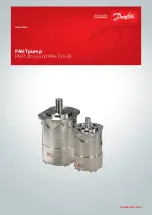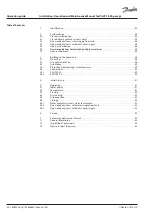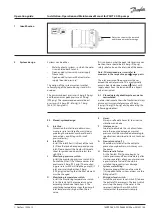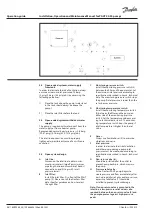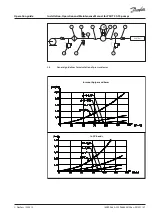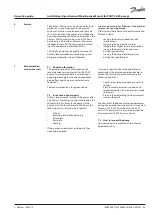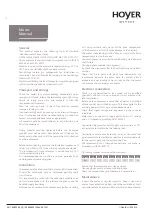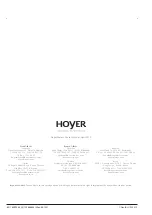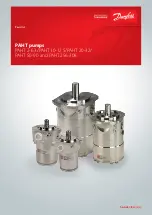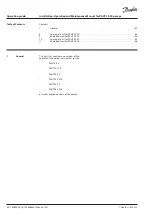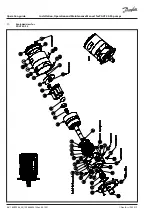
52 | 180R9288_AQ109686503100en-001301
© Danfoss | 2023.12
Operation guide
Installation, Operation and Maintenance Manual for PAHT 20-90 pumps
5.3 Pressure
The inlet pressure must be between min. 0 barg (
0 psig) and max. 6 barg (87 psig). The use of the
pump outside this range can damage the pump.
Short term inlet pressure peaks must not exceed
20 barg (290 psig). It is recommended that the
normal boost pressure is 2-6 barg (29-87 psig)
(3-7 barg [43.5-101.5 psig] abs).
If it is unknown what the peak inlet pressure can
be, then there should be a 15 barg (218 psig)
safety relief valve on the inlet side of the pump.
Max. pressure on the pump’s outlet line should
be limited at 160 barg (2320 psig) continuously.
Short-term pressure peaks (e.g. in connection
with closing of a valve) of up to 200 barg
(2900 psig) are acceptable.
It is recommended to have a check valve on the
outlet side of the pump to protect the pump
from high pressure going backwards into the
pump when it is turned off. Especially, when
using flexible hose or more pumps are installed
in the same system.
5.4 Dry running
When running, the pump must always be
connected to the water supply in order to avoid
damage if it should run dry.
In systems with water tank it is recommended to
build in a level gauge in the tank to avoid the risk
of running dry.
In systems with a boost pump, it is strongly
recommended to have a low pressure switch
mounted on the water inlet side set at minimum
2 barg (29 psig).
5.5 Disconnection
If the inlet line is disconnected from the water
supply, the pump will be emptied of water
through the disconnected inlet line. When
starting up again, follow the bleeding procedure
described under section 4: Initial start up.
5.6 Storage
When preparing the pump for long-term storage
or for temperatures below the freezing point,
flush the pump with an anti-freeze medium type
monopropylene glycol to prevent internal
corrosion or frost in the pump.
If DI water with conductivity level below 20 μS/
cm is used, you can drain the pump without
adding any other media. Just make sure that all
fluid is drained.
For further information on anti-freeze media,
please contact the Danfoss High Pressure Pumps
sales organization.
5.6.1 Water hydraulic systems, water recircu-
lated
1.
Disconnect the power pack from the
system.
2.
Empty the tank of water. Fill up the tank
with anti-freeze medium to a level well
above the suction line.
3.
Start up the power pack and, for a couple of
minutes, in a closed loop system let the
anti-freeze medium run back to tank
through the pressure relief valve or the
bypass valve.
4.
Empty the tank of the anti-freeze medium.
Empty the pump through the lower
bleeding plug.
The pump is now protected against internal
corrosion and frost.
5.6.2 Open-ended systems with water supply
from tank.
1.
Empty the tank of water and empty the
pump housing through the lower bleeding
plug. When the pump is empty, retighten
the plug.
2.
Through the upper bleeding plug, fill the
pump housing with anti-freeze medium.
Pour anti-freeze medium into the tank.
Connect a hose to the outlet of the pump
and lead the other end of the hose back to
tank.
3.
Quickly start and stop the pump.
Make
sure that the pump does not run dry.
The pump is now protected against internal
corrosion and frost.
5.6.3 Open-ended systems with direct water
supply.
1.
Disconnect the water supply to the pump.
2.
Through the lower bleeding plug, empty
the pump housing of water and close it
again.
3.
Connect the pump to a tank of eg. 25 litre
(6 gal.) of anti-freeze additive. Connect a
hose to the inlet port of the pump and via
another hose return the flow from the
outlet port port to the tank with anti-freeze
additives.
4.
Quickly start and stop the pump.
Make
sure that the pump does not run dry.
The pump is now protected against internal
corrosion and frost.






